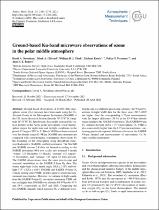| dc.contributor.author | Newnham, D A | |
| dc.contributor.author | Clilverd, M A | |
| dc.contributor.author | Clark, W D J | |
| dc.contributor.author | Michael, Kosch | |
| dc.date.accessioned | 2022-08-16T09:54:38Z | |
| dc.date.available | 2022-08-16T09:54:38Z | |
| dc.date.issued | 2021 | |
| dc.identifier.citation | Newnham, D., Clilverd, M., Clark, W., Kosch, M., Verronen, P., & Rogers, A. (2022). Ground-based Ku-band microwave observations of ozone in the polar middle atmosphere. Atmospheric Measurement Techniques, 15(8), 2361-2376. doi: 10.5194/amt-15-2361-2022 | en_US |
| dc.identifier.uri | https://doi.org:/doi: 10.5194/amt-15-2361-2022 | |
| dc.identifier.uri | http://hdl.handle.net/10566/7739 | |
| dc.description.abstract | Ground-based observations of 11.072 GHz atmospheric ozone (O3) emission have been made using the NyÅlesund
Ozone in the Mesosphere Instrument (NAOMI) at the UK Arctic Research Station (latitude 78 550000 N, longitude 11 5505900 E), Spitsbergen. Seasonally averaged O3 vertical profiles in the Arctic polar mesosphere–lower thermosphere region for night-time
and twilight conditions in the period 15 August 2017 to 15 March 2020 have been retrieved over the altitude range 62–98 km.
NAOMI measurements are compared with corresponding, overlapping observations by the Sounding of the Atmosphere using
Broadband Emission Radiometry (SABER) satellite instrument. The NAOMI and SABER version 2.0 data are binned according to the
SABER instrument 60 d yaw cycles into nominal 3-month “winter” (15 December–15 March), “autumn” (15 August– 15 November), and “summer” (15 April–15 July) periods. The NAOMI observations show the same year-to-year and seasonal variabilities as the
SABER 9.6 μm O3 data. The winter night-time (solar zenith angle, SZA 110 ) and twilight (75 SZA 110 ) NAOMI and SABER 9.6 μm O3
volume mixing ratio (VMR) profiles agree to within the measurement uncertainties. However, for autumn twilight conditions
the SABER 9.6 μm O3 secondary maximum VMR values are higher than NAOMI over altitudes 88–97 km by 47% and 59 %,
respectively in 2017 and 2018. Comparing the two SABER channels which measure O3 at different wavelengths and use different
processing schemes, the 9.6 μm O3 autumn twilight VMR data for the three years 2017–2019 are higher than the corresponding
1.27 μm measurements with the largest difference (58 %) in the 65–95 km altitude range similar to the NAOMI observation.
The SABER 9.6 μm O3 summer daytime (SZA<75 ) mesospheric O3 VMR is also consistently higher than the 1.27 μm measurement, confirming previously reported differences between the SABER 9.6 μm channel and measurements of mesospheric O3 by
other satellite instruments. | en_US |
| dc.language.iso | en | en_US |
| dc.publisher | Copernicus Publications | en_US |
| dc.subject | Atmospheric ozone | en_US |
| dc.subject | Arctic polar mesosphere | en_US |
| dc.subject | SABER instrument | en_US |
| dc.subject | Satellite | en_US |
| dc.title | Ground-based Ku-band microwave observations of ozone in the polar middle atmosphere | en_US |
| dc.type | Article | en_US |

